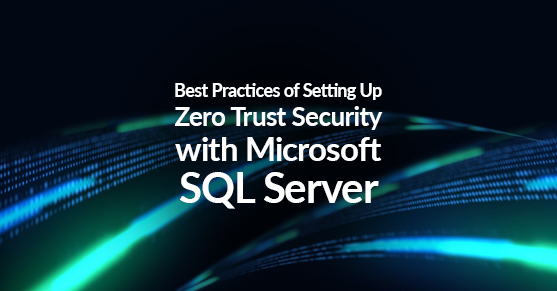In today’s constantly evolving threat landscape, traditional security models that rely on perimeter defenses are no longer enough. The zero-trust security model is becoming increasingly popular as it provides a more comprehensive approach to security. This model assumes that all users and devices, whether inside or outside the network, are untrusted until they are authenticated and authorized to access resources.
In this blog, we will explore how to establish a zero-trust security model for Microsoft SQL Server.
Steps to Implementing Zero Trust Security for Microsoft SQL Server
- Multi-Factor Authentication: Implement multi-factor authentication to ensure that only authorized users can access the database. This can be achieved through the use of hardware tokens, biometrics, or one-time codes.
- User Privileges and Access Controls: Enforce strict user privileges and access controls to limit access to sensitive data. This includes implementing role-based access control (RBAC) and regularly reviewing and updating user permissions.
- Network Segmentation: Implement network segmentation to create security zones and limit access to specific resources, such as databases. This can be achieved through the use of firewalls and virtual private networks (VPNs).
- Encryption: Implement encryption for data at rest and in transit to prevent unauthorized access to sensitive information. This includes using encryption technologies such as SSL/TLS and encrypting backups.
Potential Risks and Challenges of Implementing Zero Trust Security for Microsoft SQL Server
Implementing a zero-trust security model for Microsoft SQL Server may come with some potential risks and challenges. These include:
- Complex Implementation: Implementing a zero-trust security model can be complex and time-consuming, requiring specialized expertise and resources.
- User Resistance: Users may resist the implementation of additional security measures such as multi-factor authentication due to perceived inconvenience.
- Compatibility Issues: Some applications may not be compatible with certain security measures such as network segmentation, leading to potential disruptions and downtime.
Mitigation Tactics
To mitigate these risks and challenges, businesses can:
- Work with experienced IT professionals to implement the zero-trust security model for Microsoft SQL Server.
- Provide user training and education to help them better understand the need for additional security measures.
- Conduct compatibility testing to ensure that security measures do not disrupt business operations.
Successful Implementations of Zero Trust Security for Microsoft SQL Server
Several successful implementations of zero-trust security for Microsoft SQL Server have been reported, including at large enterprises such as Microsoft itself. The benefits of implementing a zero-trust security model include improved data protection, reduced risk of data breaches, and regulatory compliance.
Virtual-DBA’s Role in Implementing Zero Trust Security
At Virtual-DBA, we offer a range of services designed to help businesses implement zero-trust security models for Microsoft SQL Server. Our experts can work with businesses to assess their security needs, develop security strategies, and implement security measures such as multi-factor authentication, access controls, network segmentation, and encryption. By partnering with Virtual-DBA, businesses can benefit from our expertise and experience, leading to improved security and reduced risk of data breaches.
Please contact us if you have any questions or would like more information on your implementation options.

